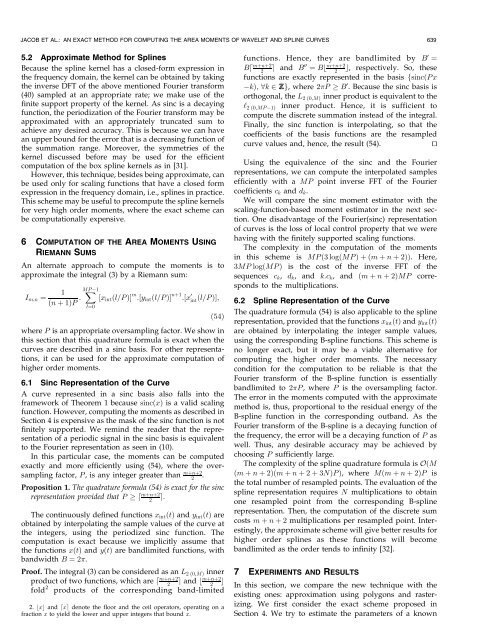An exact method for computing the area moments of ... - IEEE Xplore
An exact method for computing the area moments of ... - IEEE Xplore
An exact method for computing the area moments of ... - IEEE Xplore
- No tags were found...
Create successful ePaper yourself
Turn your PDF publications into a flip-book with our unique Google optimized e-Paper software.
JACOB ET AL.: AN EXACT METHOD FOR COMPUTING THE AREA MOMENTS OF WAVELET AND SPLINE CURVES 6395.2 Approximate Method <strong>for</strong> SplinesBecause <strong>the</strong> spline kernel has a closed-<strong>for</strong>m expression in<strong>the</strong> frequency domain, <strong>the</strong> kernel can be obtained by taking<strong>the</strong> inverse DFT <strong>of</strong> <strong>the</strong> above mentioned Fourier trans<strong>for</strong>m(40) sampled at an appropriate rate; we make use <strong>of</strong> <strong>the</strong>finite support property <strong>of</strong> <strong>the</strong> kernel. As sinc is a decayingfunction, <strong>the</strong> periodization <strong>of</strong> <strong>the</strong> Fourier trans<strong>for</strong>m may beapproximated with an appropriately truncated sum toachieve any desired accuracy. This is because we can havean upper bound <strong>for</strong> <strong>the</strong> error that is a decreasing function <strong>of</strong><strong>the</strong> summation range. Moreover, <strong>the</strong> symmetries <strong>of</strong> <strong>the</strong>kernel discussed be<strong>for</strong>e may be used <strong>for</strong> <strong>the</strong> efficientcomputation <strong>of</strong> <strong>the</strong> box spline kernels as in [31].However, this technique, besides being approximate, canbe used only <strong>for</strong> scaling functions that have a closed <strong>for</strong>mexpression in <strong>the</strong> frequency domain, i.e., splines in practice.This scheme may be useful to precompute <strong>the</strong> spline kernels<strong>for</strong> very high order <strong>moments</strong>, where <strong>the</strong> <strong>exact</strong> scheme canbe computationally expensive.6 COMPUTATION OF THE AREA MOMENTS USINGRIEMANN SUMS<strong>An</strong> alternate approach to compute <strong>the</strong> <strong>moments</strong> is toapproximate <strong>the</strong> integral (3) by a Riemann sum:1MP1I m;n ˆ…n ‡ 1†P : X‰x int …l=P †Š m :‰y int …l=P †Š n‡1 :‰x 0 int …l=P †Š;lˆ0…54†where P is an appropriate oversampling factor. We show inthis section that this quadrature <strong>for</strong>mula is <strong>exact</strong> when <strong>the</strong>curves are described in a sinc basis. For o<strong>the</strong>r representations,it can be used <strong>for</strong> <strong>the</strong> approximate computation <strong>of</strong>higher order <strong>moments</strong>.6.1 Sinc Representation <strong>of</strong> <strong>the</strong> CurveA curve represented in a sinc basis also falls into <strong>the</strong>framework <strong>of</strong> Theorem 1 because sinc…x† is a valid scalingfunction. However, <strong>computing</strong> <strong>the</strong> <strong>moments</strong> as described inSection 4 is expensive as <strong>the</strong> mask <strong>of</strong> <strong>the</strong> sinc function is notfinitely supported. We remind <strong>the</strong> reader that <strong>the</strong> representation<strong>of</strong> a periodic signal in <strong>the</strong> sinc basis is equivalentto <strong>the</strong> Fourier representation as seen in (10).In this particular case, <strong>the</strong> <strong>moments</strong> can be computed<strong>exact</strong>ly and more efficiently using (54), where <strong>the</strong> oversamplingfactor, P , is any integer greater than m‡n‡22.Proposition 1. The quadrature <strong>for</strong>mula (54) is <strong>exact</strong> <strong>for</strong> <strong>the</strong> sincrepresentation provided that P d m‡n‡22e.The continuously defined functions x int …t† and y int …t† areobtained by interpolating <strong>the</strong> sample values <strong>of</strong> <strong>the</strong> curve at<strong>the</strong> integers, using <strong>the</strong> periodized sinc function. Thecomputation is <strong>exact</strong> because we implicitly assume that<strong>the</strong> functions x…t† and y…t† are bandlimited functions, withbandwidth B ˆ 2.Pro<strong>of</strong>. The integral (3) can be considered as an L 2 …0;M† innerproduct <strong>of</strong> two functions, which are d m‡n‡22e and b m‡n‡22cfold 2 products <strong>of</strong> <strong>the</strong> corresponding band-limited2. bxc and dxe denote <strong>the</strong> floor and <strong>the</strong> ceil operators, operating on afraction x to yield <strong>the</strong> lower and upper integers that bound x.functions. Hence, <strong>the</strong>y are bandlimited by B 0 ˆBd m‡n‡22e and B 00 ˆ Bb m‡n‡22c, respectively. So, <strong>the</strong>sefunctions are <strong>exact</strong>ly represented in <strong>the</strong> basis fsinc…Pxk†; 8k 2 Zg, where 2P B 0 . Because <strong>the</strong> sinc basis isorthogonal, <strong>the</strong> L 2 …0;M† inner product is equivalent to <strong>the</strong>`2 …0;MP1† inner product. Hence, it is sufficient tocompute <strong>the</strong> discrete summation instead <strong>of</strong> <strong>the</strong> integral.Finally, <strong>the</strong> sinc function is interpolating, so that <strong>the</strong>coefficients <strong>of</strong> <strong>the</strong> basis functions are <strong>the</strong> resampledcurve values and, hence, <strong>the</strong> result (54).tuUsing <strong>the</strong> equivalence <strong>of</strong> <strong>the</strong> sinc and <strong>the</strong> Fourierrepresentations, we can compute <strong>the</strong> interpolated samplesefficiently with a MP point inverse FFT <strong>of</strong> <strong>the</strong> Fouriercoefficients c k and d k .We will compare <strong>the</strong> sinc moment estimator with <strong>the</strong>scaling-function-based moment estimator in <strong>the</strong> next section.One disadvantage <strong>of</strong> <strong>the</strong> Fourier(sinc) representation<strong>of</strong> curves is <strong>the</strong> loss <strong>of</strong> local control property that we werehaving with <strong>the</strong> finitely supported scaling functions.The complexity in <strong>the</strong> computation <strong>of</strong> <strong>the</strong> <strong>moments</strong>in this scheme is MP…3 log…MP†‡…m ‡ n ‡ 2††. Here,3MP log…MP† is <strong>the</strong> cost <strong>of</strong> <strong>the</strong> inverse FFT <strong>of</strong> <strong>the</strong>sequences c k , d k , and k:c k , and …m ‡ n ‡ 2†MP correspondsto <strong>the</strong> multiplications.6.2 Spline Representation <strong>of</strong> <strong>the</strong> CurveThe quadrature <strong>for</strong>mula (54) is also applicable to <strong>the</strong> splinerepresentation, provided that <strong>the</strong> functions x int …t† and y int …t†are obtained by interpolating <strong>the</strong> integer sample values,using <strong>the</strong> corresponding B-spline functions. This scheme isno longer <strong>exact</strong>, but it may be a viable alternative <strong>for</strong><strong>computing</strong> <strong>the</strong> higher order <strong>moments</strong>. The necessarycondition <strong>for</strong> <strong>the</strong> computation to be reliable is that <strong>the</strong>Fourier trans<strong>for</strong>m <strong>of</strong> <strong>the</strong> B-spline function is essentiallybandlimited to 2P, where P is <strong>the</strong> oversampling factor.The error in <strong>the</strong> <strong>moments</strong> computed with <strong>the</strong> approximate<strong>method</strong> is, thus, proportional to <strong>the</strong> residual energy <strong>of</strong> <strong>the</strong>B-spline function in <strong>the</strong> corresponding outband. As <strong>the</strong>Fourier trans<strong>for</strong>m <strong>of</strong> <strong>the</strong> B-spline is a decaying function <strong>of</strong><strong>the</strong> frequency, <strong>the</strong> error will be a decaying function <strong>of</strong> P aswell. Thus, any desirable accuracy may be achieved bychoosing P sufficiently large.The complexity <strong>of</strong> <strong>the</strong> spline quadrature <strong>for</strong>mula is O…M…m ‡ n ‡ 2†…m ‡ n ‡ 2 ‡ 3N†P†, where M…m ‡ n ‡ 2†P is<strong>the</strong> total number <strong>of</strong> resampled points. The evaluation <strong>of</strong> <strong>the</strong>spline representation requires N multiplications to obtainone resampled point from <strong>the</strong> corresponding B-splinerepresentation. Then, <strong>the</strong> computation <strong>of</strong> <strong>the</strong> discrete sumcosts m ‡ n ‡ 2 multiplications per resampled point. Interestingly,<strong>the</strong> approximate scheme will give better results <strong>for</strong>higher order splines as <strong>the</strong>se functions will becomebandlimited as <strong>the</strong> order tends to infinity [32].7 EXPERIMENTS AND RESULTSIn this section, we compare <strong>the</strong> new technique with <strong>the</strong>existing ones: approximation using polygons and rasterizing.We first consider <strong>the</strong> <strong>exact</strong> scheme proposed inSection 4. We try to estimate <strong>the</strong> parameters <strong>of</strong> a known
















